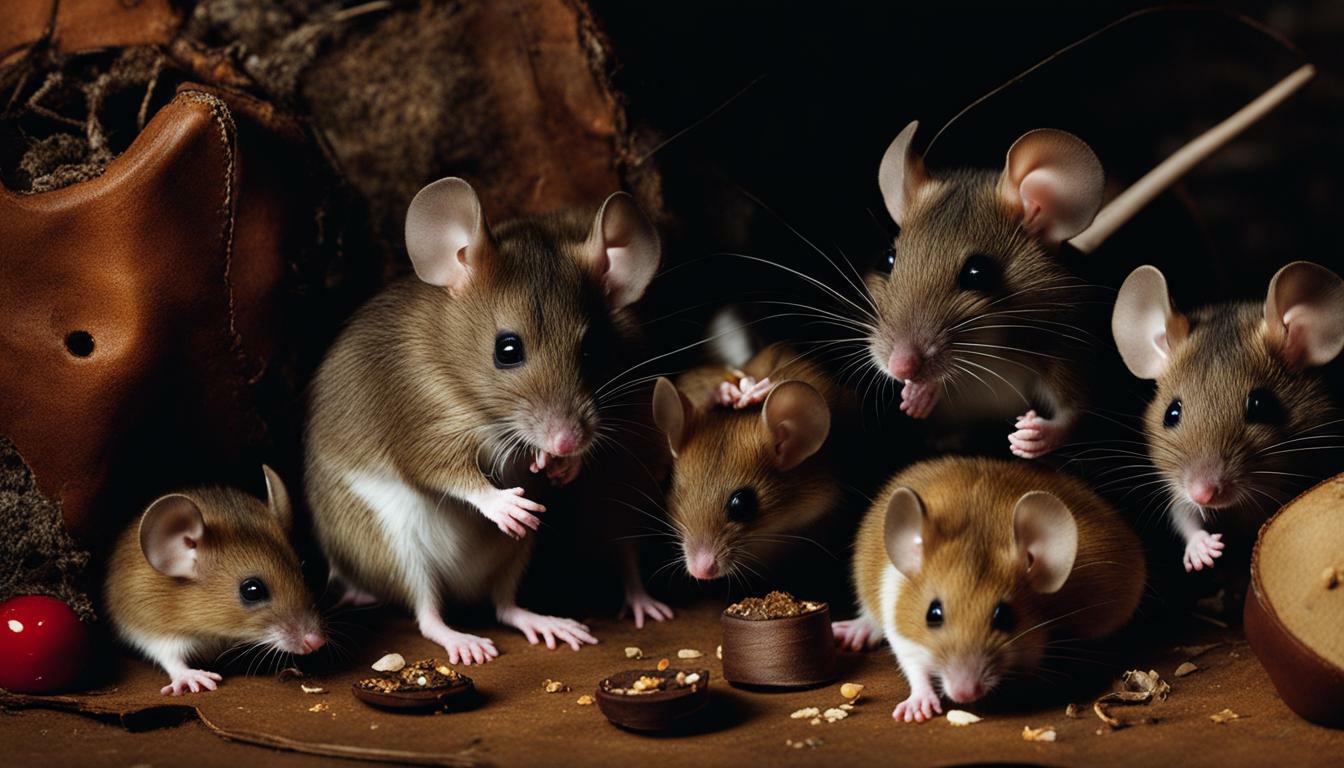Are you wondering if mice have a tendency to eat shoes? Understanding their eating habits and the potential damage they can cause is essential for keeping your footwear safe.
Mice can cause damage to shoes by chewing through them and using the material to make nests. They may also leave urine and feces on the shoes, which can be unpleasant and unsanitary. It is important to take precautions and remove shoes if there are signs of mice in the area.
Key Takeaways:
- Mice can chew through shoes, causing damage to the material.
- They may use shoe material to build nests.
- Mice can leave urine and feces on shoes, which can be unsanitary.
- Removing shoes if there are signs of mice can help prevent further damage and potential health hazards.
- Taking proactive measures, such as proper storage and deterrent methods, can help protect your shoes from mice infestations.
Mice Feeding Habits
Mice are omnivorous creatures that will eat almost anything they can find, including shoes. Understanding their feeding habits can help us better protect our footwear from these pesky pests.
When it comes to shoes, mice are attracted to the materials commonly used in their construction, such as leather, fabric, and rubber. These materials provide mice with ample opportunities to gnaw and shred, which they do to create nests and to satisfy their natural instinct to wear down their constantly growing teeth.
It’s important to note that mice don’t actually consume the shoes for nourishment; instead, they use the materials for nesting purposes and to create comfortable living spaces. However, their chewing can cause significant damage to our beloved footwear, rendering them unwearable and in need of repair or replacement.
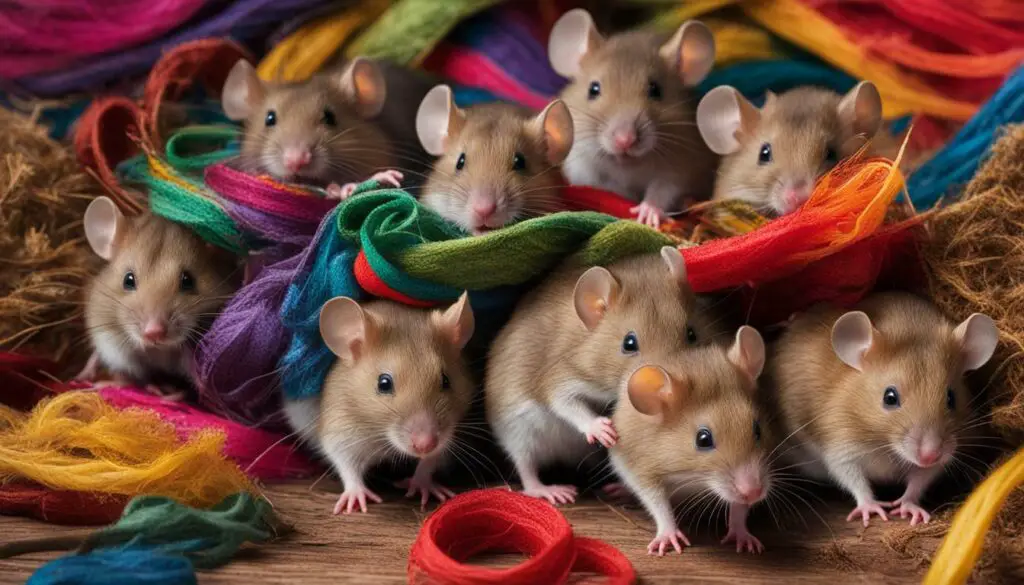
To effectively prevent mice from feasting on our shoes, it’s essential to address the root cause- their presence. By implementing measures to deter mice and control their infestation, we can safeguard our footwear and keep our shoes intact for longer periods.
| Materials | Attraction Level |
|---|---|
| Leather | High |
| Fabric | Medium |
| Rubber | Low |
In addition to shoes, mice are also known to feed on grains, seeds, fruits, vegetables, and even insects. Keeping food sources properly stored and sealed can help minimize the likelihood of attracting mice into our homes and, consequently, our shoe collections.
To learn more about the damage caused by mice and how to protect your shoes, continue reading the following sections.
Damage Caused by Mice
Mice can wreak havoc on shoes, chewing through the material and causing irreparable damage. Their sharp teeth can tear apart fabric, leather, and even rubber soles. This can not only ruin the aesthetics of your favorite pair of shoes but also render them unwearable. Additionally, mice may use the shredded material to build nests, further damaging your footwear. It’s important to be aware of the signs of mice infestation and take appropriate measures to protect your shoes.
One of the notable indications of mice activity is the presence of chewed-up material. If you notice small holes or gnaw marks on your shoes, it’s likely that mice have been at work. They are particularly fond of warm and cozy materials, such as wool or insulation, which they use to create nests. Another sign to watch out for is the presence of urine and feces. Mice tend to mark their territory, and if they have been using your shoes as their playground, you may find droppings nearby. This not only poses a hygiene concern but also indicates an active mice infestation.
To better understand the extent of the damage caused by mice, it’s crucial to assess the health risks. Mice carry various pathogens in their droppings, which can contaminate your shoes and pose a threat to your wellbeing. These pathogens can be transferred to other surfaces, leading to the dispersion of harmful bacteria. Therefore, it is imperative to keep your shoes clean and free of mice.
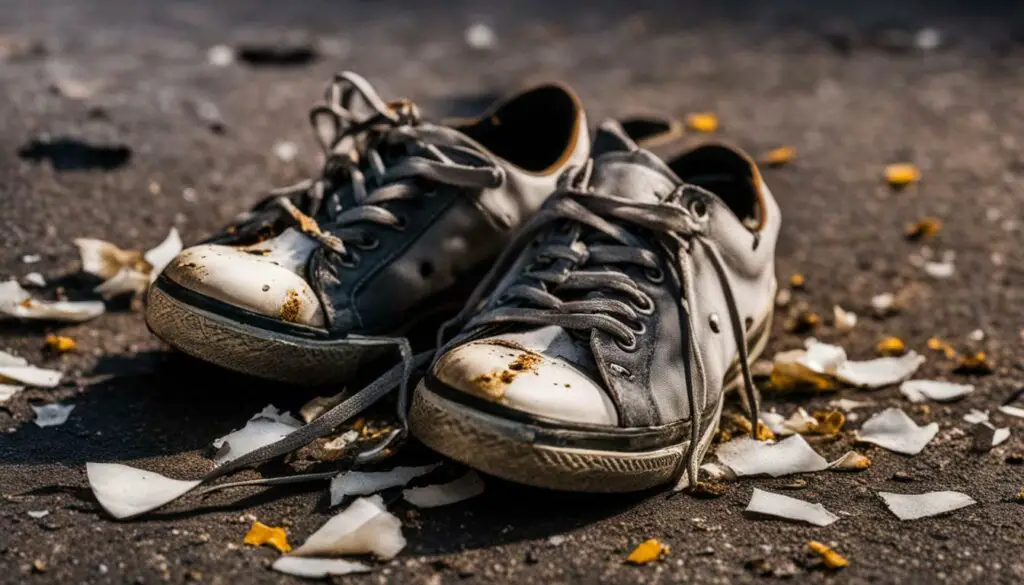 In order to protect your shoes from mice, consider implementing preventive measures such as proper storage and regular inspection. Keep your shoes off the floor by using shoe racks or storage containers with lids. Inspect your shoes periodically for signs of chewing or other damage. If you detect any evidence of mice infestation, take immediate action to eliminate the problem. This may involve setting up traps or contacting a professional pest control service. By being proactive and vigilant, you can safeguard your precious footwear from the destructive tendencies of mice.
In order to protect your shoes from mice, consider implementing preventive measures such as proper storage and regular inspection. Keep your shoes off the floor by using shoe racks or storage containers with lids. Inspect your shoes periodically for signs of chewing or other damage. If you detect any evidence of mice infestation, take immediate action to eliminate the problem. This may involve setting up traps or contacting a professional pest control service. By being proactive and vigilant, you can safeguard your precious footwear from the destructive tendencies of mice.
Signs of Mice Infestation
It’s important to be able to recognize the signs of mice infestation in order to protect your shoes from being eaten. Mice are known for their destructive behavior, and when it comes to shoes, they can wreak havoc. One telltale sign of a mouse infestation is finding chewed-up materials, such as shoelaces or insoles. They may also leave behind trails of droppings and urine, which can create an unpleasant and unsanitary environment.
To further confirm a mice infestation, look out for small holes or gnaw marks on your shoes. Mice have a habit of chewing through various materials, including leather, fabric, and rubber, to make nests or gather materials for their nests. These distinctive signs are a clear indication that mice are causing damage to your shoes.
Another sign of mice infestation is the presence of a musty odor. Mice tend to urinate frequently, and their urine can leave a distinct smell on your shoes. If you notice a strong, foul odor coming from your shoes, it’s likely that mice have been in contact with them.
Summary:
- Look for chewed-up materials and gnaw marks on your shoes.
- Check for trails of droppings and urine.
- Pay attention to a musty odor coming from your shoes.
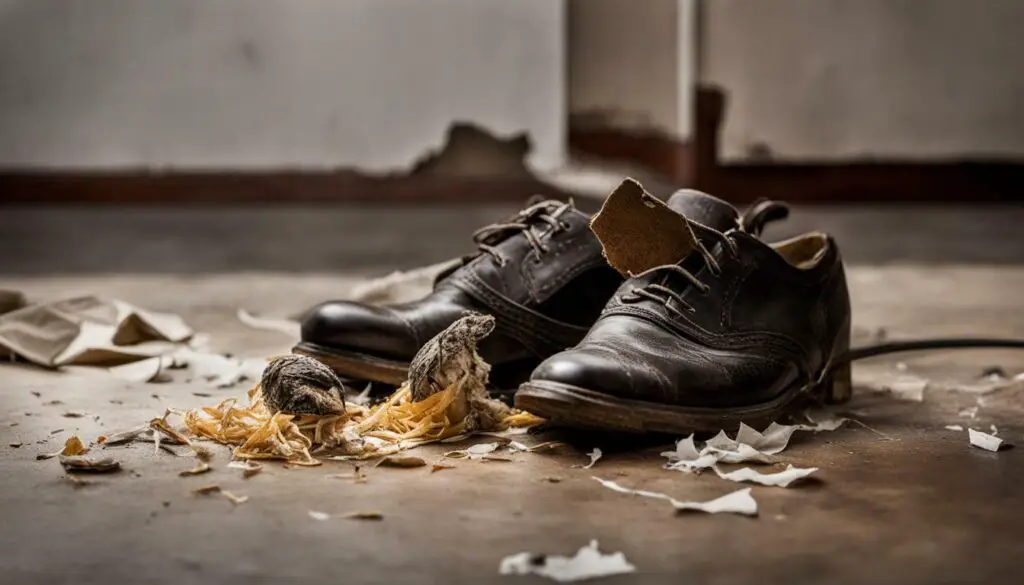
| Signs of Mice Infestation | Description |
|---|---|
| Chewed-up materials | Finding chewed-up shoelaces, insoles, or other shoe components. |
| Gnaw marks | Small holes or distinct marks caused by mice chewing on shoes. |
| Droppings and urine trails | Visible trails of mouse droppings or urine stains on shoes. |
| Musty odor | A strong, unpleasant smell coming from the shoes due to mouse urine. |
Prevention from Mice Chewing Shoes
Taking preventive measures is key to safeguarding your shoes from mice damage. These pesky rodents have a penchant for chewing through materials to create nests, leaving behind unsightly and unsanitary conditions. By implementing the following strategies, you can minimize the risk of mice infestation and protect your precious footwear.
1. Seal Entry Points
Mice can squeeze through tiny openings, so it’s important to seal any potential entry points in your home. Inspect your doors, windows, and walls for gaps, cracks, or holes, and use caulk or weatherstripping to seal them. Pay special attention to areas near your shoe storage, as mice are attracted to the scent of footwear.
2. Keep a Clean Environment
Mice are attracted to food and clutter, so maintaining cleanliness is crucial. Regularly vacuum and sweep your shoe storage area, removing any crumbs or debris that may attract these rodents. Store your shoes in a clean and organized manner, using containers or shelves that mice cannot easily access.
3. Utilize Deterrents
There are various natural deterrents that can help keep mice away from your shoes. Peppermint oil, for example, has a strong scent that repels rodents. Place cotton balls soaked in peppermint oil near your shoe storage to create a barrier. Another option is to use ultrasonic repellent devices that emit high-frequency sounds, which are unpleasant for mice but inaudible to humans.
| Deterrent | Effectiveness |
|---|---|
| Peppermint oil | Repels mice with a strong scent |
| Ultrasonic repellent devices | Emits high-frequency sounds that deter mice |

By implementing these preventive measures, you can significantly reduce the risk of mice damaging your shoes. Remember to regularly monitor your shoe storage area for any signs of mice, such as droppings, gnaw marks, or an unpleasant odor. If you suspect an infestation, it’s best to seek professional help to safely and effectively eliminate the problem.
Protecting Shoes from Mice
There are several effective ways to protect your shoes from mice and deter them from chewing on them. These furry pests can cause significant damage to your footwear, ruining your favorite pairs and leaving behind unsanitary messes. By taking proactive measures, you can safeguard your shoes and prevent a mice infestation in your storage area.
One of the best deterrent methods is to store your shoes in sealed containers or boxes. Mice are less likely to target shoes that are securely enclosed, as they prefer easy access to materials for building their nests. Additionally, placing scented repellents, such as peppermint oil or mothballs, near your shoes can help keep mice at bay.
Another effective strategy is to keep your storage area clean and tidy. Regularly vacuuming and sweeping removes any food crumbs or debris that may attract mice. Additionally, consider using metal shelving instead of wooden ones, as mice can easily gnaw through wood. Keeping your storage area well-lit can also discourage mice, as they prefer dark and secluded spaces.
Additional Tips for Protecting Shoes from Mice
When it comes to protecting your shoes from mice, prevention is key. Here are some additional tips:
- Seal any gaps or cracks around your storage area to prevent mice from entering.
- Store any food or pet food in sealed containers to eliminate potential attractants.
- Place traps or bait stations strategically around your storage area to catch any mice that may have found their way in.
- Regularly inspect your shoes for any signs of mice activity, such as chew marks or droppings, and take immediate action if you suspect an infestation.
By following these preventive measures and implementing effective deterrent methods, you can protect your shoes from mice and ensure they remain in good condition for years to come.
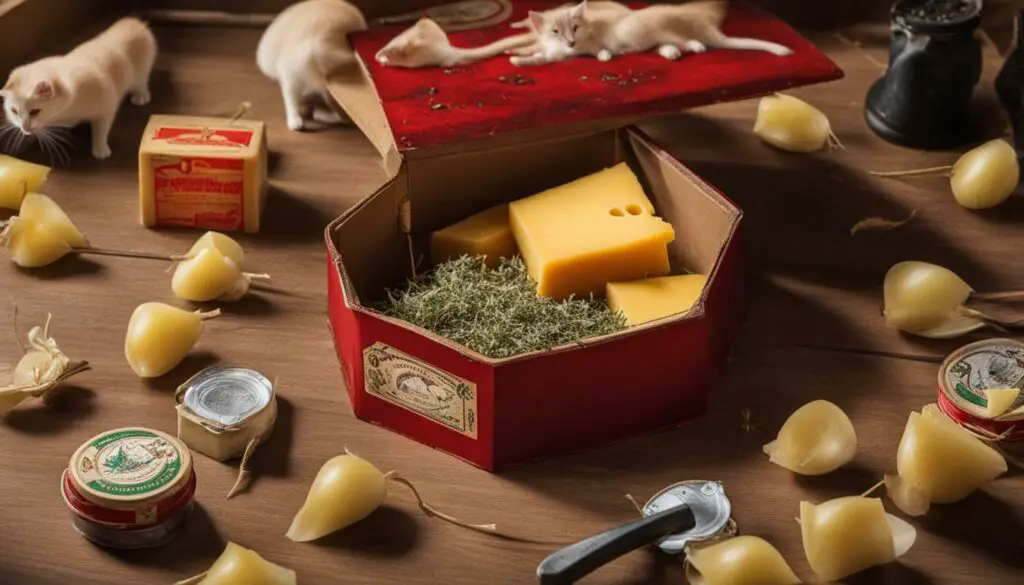
Implementing proper mice control measures in shoe storage is crucial for preserving your footwear collection. Mice can cause significant damage to your shoes by chewing through them to make nests or even using the material for constructing their nests elsewhere. This can lead to irreparable damage, leaving your favorite pair of shoes ruined. Moreover, mice may also leave urine and feces on your shoes, resulting in unpleasant odors and unsanitary conditions.
To prevent mice infestations in your shoe storage area, it is essential to take proactive steps to deter them. Begin by thoroughly inspecting the storage area for any signs of mice, such as droppings, gnaw marks, or nesting materials. If you notice any indications of mice activity, it is crucial to address the issue promptly to prevent further damage.
| Effective Mice Control Measures: |
|---|
| 1. Seal any gaps or cracks in the walls, doors, or floors that could serve as entry points for mice. |
| 2. Keep the storage area clean and clutter-free. Regularly vacuum and sweep the floor to remove any potential food sources for mice. |
| 3. Store your shoes in sturdy plastic containers with airtight lids, as mice cannot chew through this material. |
| 4. Avoid storing shoes in cardboard boxes or bags, as these are easily accessible to mice. |
| 5. Use mouse repellents, such as peppermint oil, mothballs, or ultrasonic devices, to deter mice from approaching your shoe storage area. |
By following these mice control measures, you can significantly reduce the risk of mice infestations in your shoe storage space. Remember to regularly inspect your shoes for any signs of damage or mice activity, so you can take immediate action to protect your footwear collection.
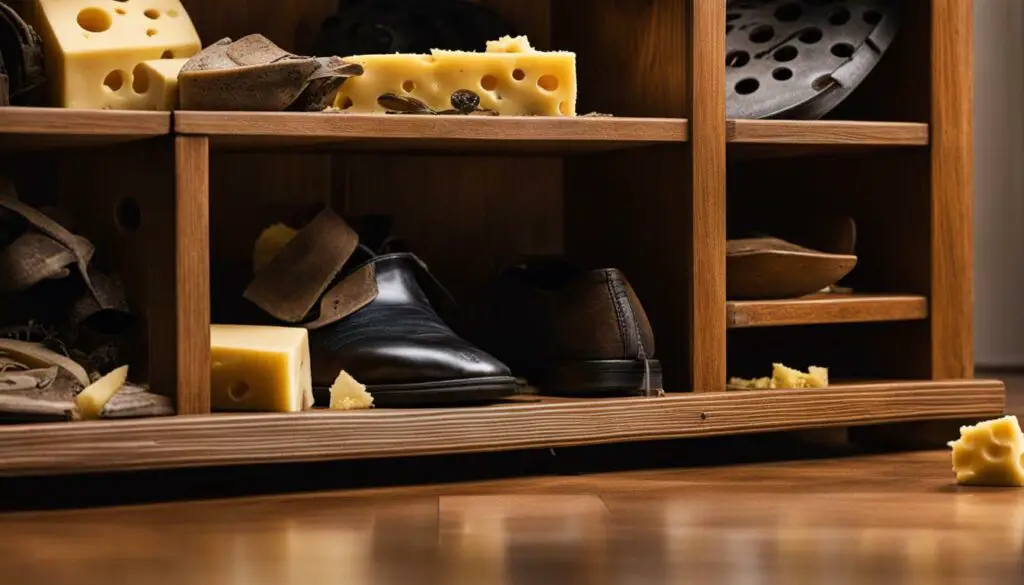
Maintaining a mice-free environment requires a combination of preventive methods and active measures to keep them away from your shoes. These tiny rodents can cause damage and leave unsanitary conditions if left unchecked. Here are some effective mice deterrent methods to consider:
- Seal entry points: Mice can squeeze through small openings, so it’s important to seal any cracks or gaps in walls, floors, or storage areas. Use caulk or steel wool to block these entry points.
- Keep a clean environment: Mice are attracted to food crumbs and waste, so regularly clean your shoe storage area and surrounding spaces. Store shoes in sealed containers to minimize potential attractants.
- Use natural repellents: Mice dislike certain strong scents. Consider using natural repellents like mint, peppermint oil, or dryer sheets near your shoes to deter them.
If you’ve already noticed signs of mice in your shoe storage area, take immediate action:
- Remove affected shoes: Inspect your shoes for any signs of chewing or nesting material. If you discover damage or evidence of mice, remove the affected shoes to prevent further spread of infestation.
- Set traps: Place snap traps or humane traps near your shoe storage area to catch mice. Peanut butter or chocolate can be effective bait options. Check the traps regularly and dispose of captured mice properly.
By implementing these mice deterrent methods and taking swift action in case of infestation, you can protect your shoes from damage and maintain a clean and safe environment. Remember to stay vigilant and monitor your shoe storage area regularly for signs of mice.
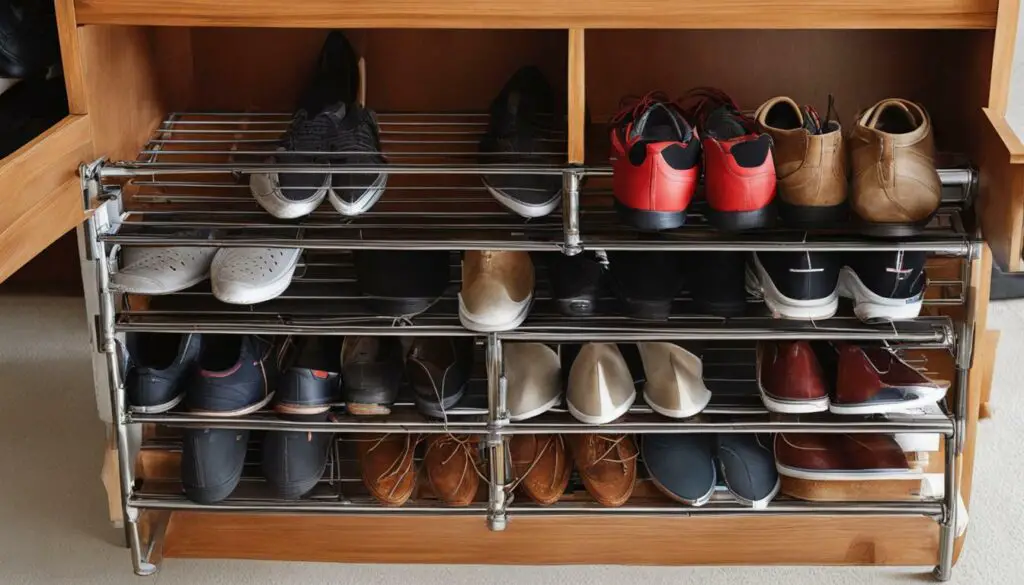
There are various mice deterrent methods available that can effectively discourage mice from coming near your shoes. By implementing these strategies, you can protect your footwear from potential damage and ensure a mice-free environment. Here are some effective mice deterrent methods:
- Maintain cleanliness: Mice are attracted to food and shelter. By keeping your shoe storage area clean and free of crumbs or food residue, you can discourage mice from seeking shelter there. Regularly sweep and vacuum the area to eliminate any potential food sources.
- Use peppermint oil: Mice have a strong aversion to the scent of peppermint oil. Soak cotton balls in peppermint oil and place them near your shoes. The strong fragrance will help deter mice from approaching your footwear.
- Seal entry points: Inspect your shoe storage area for any gaps or holes that mice can use to enter. Seal these entry points with caulk or steel wool to prevent mice from accessing your shoes. Remember, mice can fit through incredibly small openings, so be thorough in your inspection.
To further enhance your mice deterrent efforts, you can also consider using ultrasonic devices or natural repellents such as mothballs or fabric softener sheets. However, it’s important to note that these methods may not be as effective as the ones mentioned above. Additionally, if you suspect a mice infestation, it’s advisable to seek professional help to ensure complete eradication of the problem.
| Mice Deterrent Methods | Effectiveness |
|---|---|
| Cleanliness | High |
| Peppermint oil | Moderate |
| Sealing entry points | High |
| Ultrasonic devices | Varies |
| Natural repellents | Varies |
Remember, prevention is key when it comes to protecting your shoes from mice. By implementing these mice deterrent methods and taking proactive measures, you can ensure that your footwear remains safe and free from any unwanted furry visitors.
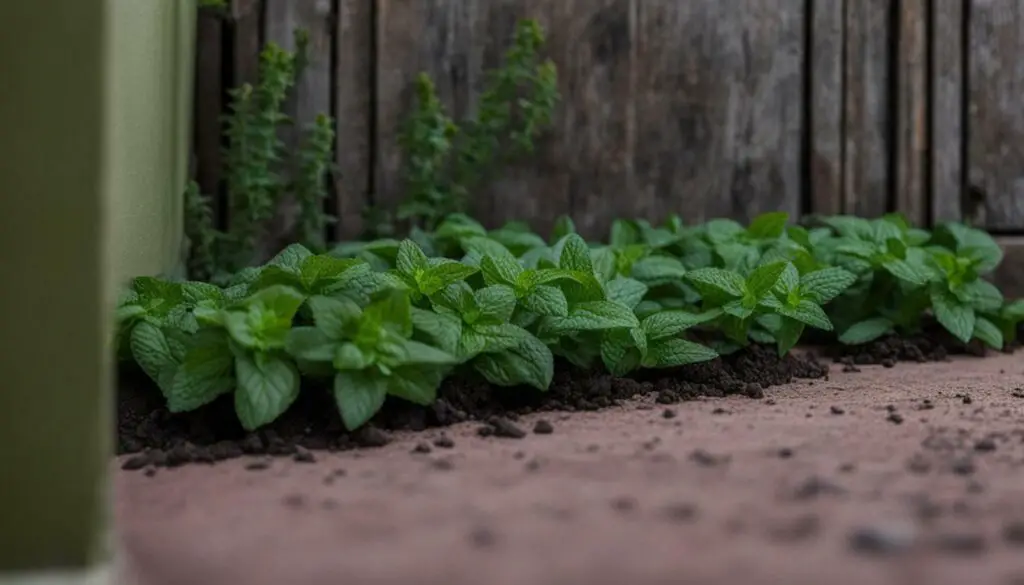
By being aware of the signs of mice infestation and taking proactive steps to protect your shoes, you can ensure they remain intact and free from mice damage.
Mice can cause significant damage to shoes by chewing through them and using the materials for their nests. This can leave you with ruined shoes and potentially expose you to unsanitary conditions due to the urine and feces that mice can leave behind.
Therefore, it is essential to be vigilant and take necessary precautions if you suspect mice in your home or storage areas. Look out for signs such as chewed materials, droppings, and a musky odor, as these may indicate a mice infestation.
To protect your shoes, consider storing them in sealed containers or using mouse-proof storage solutions. Keep your storage areas clean and clutter-free, as mice are attracted to food sources and hiding spots. Additionally, you can use deterrent methods, such as peppermint oil or ultrasonic devices, to discourage mice from approaching your shoes.
Remember, early detection and prevention are key to keeping your shoes safe from mice. By implementing these measures, you can safeguard your footwear and prevent any unwanted surprises when you reach for a pair.
FAQ
Do mice eat shoes?
Yes, mice can chew through shoes and use the material to make nests. They may also leave urine and feces on the shoes.
What damage can mice cause to shoes?
Mice can chew through shoes, causing material damage. They may also leave unpleasant and unsanitary urine and feces on the shoes.
How can I tell if there are mice in my shoes?
Signs of mice infestation include chewed up shoes, urine or feces on the shoes, and sightings of mice in the area where the shoes are stored.
How can I prevent mice from chewing my shoes?
To prevent mice from chewing your shoes, ensure proper storage in sealed containers, keep your environment clean, and use deterrent methods like traps or repellents.
What are some effective mice deterrent methods?
Some effective mice deterrent methods include sealing potential entry points, keeping food sources inaccessible, using ultrasonic devices, and setting up traps in strategic areas.
How can I keep mice away from my shoes?
To keep mice away from your shoes, practice good hygiene, regularly inspect your storage areas, maintain cleanliness, and use protective measures like repellents or storage solutions.
What should I do if I find mice in my shoe storage?
If you find mice in your shoe storage, take immediate action by removing the affected shoes, cleaning the area thoroughly, and implementing measures to prevent further infestations, such as sealing entry points and using traps.

